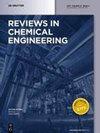用于烷烃脱氢的催化膜反应器:催化和分离过程的集成
IF 6.6
3区 工程技术
Q1 ENGINEERING, CHEMICAL
引用次数: 0
摘要
摘要通过释放化学计量量的氢气将饱和烃催化脱氢为相应的烯烃是安全储存氢气的首要解决方案。催化膜反应器用于该方法通过在反应过程中选择性地同时去除产生的H2来提高超过热力学平衡的反应产率。为此,本综述的重点是H2可渗透膜与催化剂的集成,用于轻质烷烃的脱氢,以在一步中共同生产烯烃和高纯度氢气。此外,本文还对液态有机氢载体的脱氢安全储氢进行了综述。本文重点介绍了用于脱氢反应的不同类型的H2渗透选择性膜,并详细讨论了碳氢化合物对H2通过这些膜渗透的影响。此外,对用于直链烷烃和环状烷烃脱氢的膜反应器的模拟研究和实验研究进行了批判性的回顾,以发现模拟与实验结果之间的一致性。系统地讨论了不同类型的烷烃脱氢反应及其影响反应性能的参数。最后,为制备更便宜、大规模的脱氢反应膜反应器提供了指导。将放热反应与吸热脱氢反应耦合的概念作为未来的方向研究,以提高集成膜反应器的总产率和能源效率。本文章由计算机程序翻译,如有差异,请以英文原文为准。
Catalytic membrane reactors for alkane dehydrogenation applications: an integration of catalysis and separation process
Abstract Catalytic dehydrogenation of saturated hydrocarbons to corresponding alkenes by the release of the stoichiometric amount of hydrogen is the paramount solution for safe storage of hydrogen. The utilization of a catalytic membrane reactor for this process enhances the reaction yield beyond thermodynamic equilibrium by selectively and simultaneously removing the produced H2 during the reaction. To this end, the present review is focused on the integration of H2 permeable membranes with the catalysts for dehydrogenation of lighter alkanes for coproduction of olefins and high-purity hydrogen in a single step. Besides, this review also covers dehydrogenation of liquid organic hydrogen carriers for safe storage of hydrogen. Herein, different types of H2 perm-selective membranes used for the dehydrogenation reaction are highlighted and the effect of hydrocarbon on H2 permeation through these membranes are discussed in detail. Furthermore, the simulation studies along with the experimental investigation performed on the membrane reactors for dehydrogenation of linear and cyclic alkanes are critically reviewed to find the coherence between simulation and experimental findings. Systematic discussion is done on the different types of alkane dehydrogenation reactions and the parameters affecting the reaction performance. Finally, directions are provided to prepare a cheaper and large industrial scale membrane reactor for dehydrogenation reaction. The concept of coupling an exothermic reaction with the endothermic dehydrogenation reaction is provided as a future direction study to enhance the overall yield and energy efficiency of the integrated membrane reactor.
求助全文
通过发布文献求助,成功后即可免费获取论文全文。
去求助
来源期刊

Reviews in Chemical Engineering
工程技术-工程:化工
CiteScore
12.30
自引率
0.00%
发文量
37
审稿时长
6 months
期刊介绍:
Reviews in Chemical Engineering publishes authoritative review articles on all aspects of the broad field of chemical engineering and applied chemistry. Its aim is to develop new insights and understanding and to promote interest and research activity in chemical engineering, as well as the application of new developments in these areas. The bimonthly journal publishes peer-reviewed articles by leading chemical engineers, applied scientists and mathematicians. The broad interest today in solutions through chemistry to some of the world’s most challenging problems ensures that Reviews in Chemical Engineering will play a significant role in the growth of the field as a whole.
 求助内容:
求助内容: 应助结果提醒方式:
应助结果提醒方式:


